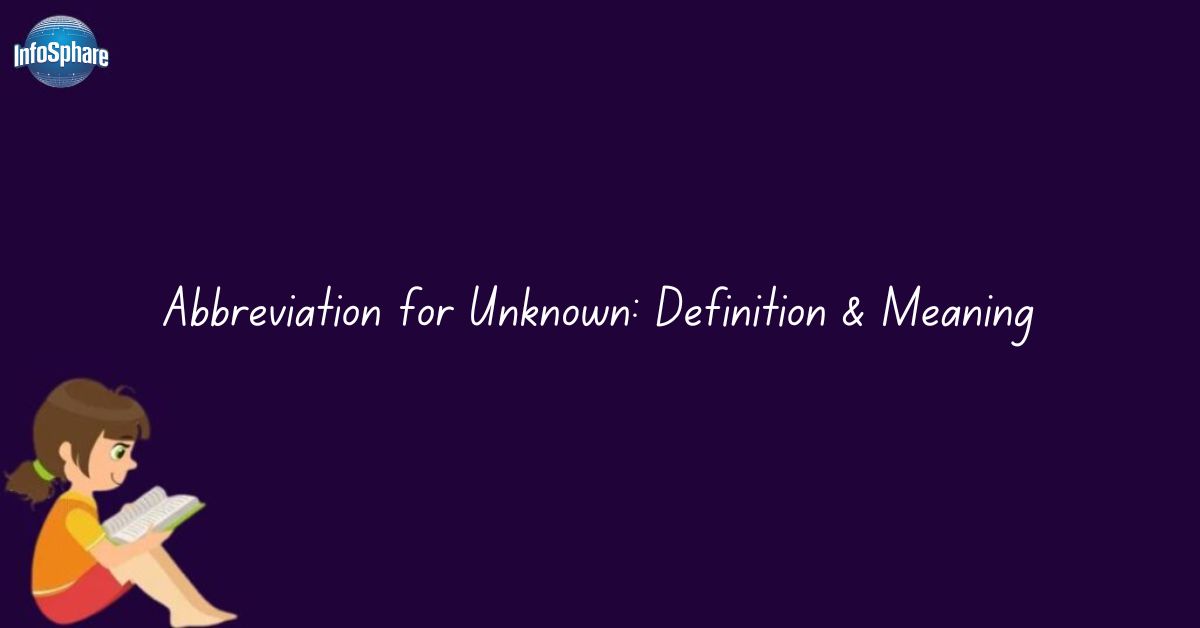The abbreviation for unknown,” which is “UNK,” may seem straightforward, but it’s very important for quick and clear communication. This is especially true in areas like medical records, research, and legal documents. Whether you’re filling out a form, reading a study, or checking a patient’s file, knowing what “UNK” means can help you understand the information better.
Are you interested in learning how to use this abbreviation in different situations? Or maybe you’re unsure if it fits your needs? Keep reading to discover everything you need to know about “UNK” and how to use it effectively!
What is the Abbreviation for Unknown?
When you encounter the term “unknown,” it often gets shortened to “UNK.” This abbreviation serves as a quick reference in various fields, like medical records, legal documents, and scientific research. Using UNK streamlines communication, especially when dealing with large amounts of data.
It allows professionals to indicate that certain information is either not identified or unavailable without lengthy explanations. You might also see other abbreviations like “U” or “N/A” (Not Applicable) depending on the context. Understanding these shorthand terms can improve how you interact with forms, reports, and data collection processes.
Common Abbreviations for “Unknown”:
- UNK: The most recognized abbreviation for “unknown,” widely used in both formal and informal settings.
- U: A simpler shorthand that you might find in casual communication, especially texts or notes.
- N/A: While it stands for “Not Applicable,” it sometimes replaces “unknown” in forms where the information simply doesn’t apply.
Familiarity with these abbreviations helps ensure you communicate effectively and avoid confusion in professional settings.
What Does “Unknown” Mean?

The term “unknown” refers to something that remains unidentified, unrecognized, or not fully understood. It describes various situations where crucial information is missing or yet to be discovered. For instance, in a medical context, a patient’s prior medical history might be labeled as unknown if it hasn’t been documented.
Similarly, in scientific research, you might encounter unknown variables that affect the outcome of an experiment. This term applies across different fields, highlighting a gap in knowledge or information.
Examples of “Unknown” Usage:
- Unidentified Person: “The identity of the suspect remains unknown.”
- Unknown Cause: “The reason for the sudden failure is still unknown.”
- Unknown Data: “Several data points were recorded as unknown during the survey.”
Using the term “unknown” effectively communicates uncertainty, whether you’re discussing a medical condition, a scientific phenomenon, or a legal matter. Understanding its implications can deepen your grasp of complex topics and enhance your communication skills.
Understanding the Word “Unknown”: Pronunciation and Usage
The word “unknown” is pronounced as /ʌnˈnoʊn/, breaking down into two clear syllables: “un” and “known.” This pronunciation makes it easy to say and understand. In everyday language, unknown describes anything that isn’t identified or understood.
You might use it in contexts that range from casual conversation to formal writing. For instance, when discussing a mystery, you might say, “The cause of the event remains unknown.” Grasping how to use “unknown” correctly can enhance your clarity and effectiveness in communication.
Example Sentences:
- “The identity of the caller is unknown to the police.”
- “Researchers are investigating the unknown variables that affect climate change.”
- “The unknown origins of the artifact intrigue historians.”
These sentences illustrate how “unknown” can encapsulate various scenarios, from personal identities to scientific inquiries, thereby enriching your vocabulary.
Also Read this: CNC Meaning: Internet Urban Slang
Short Abbreviation for Unknown: Why and How It’s Used

The abbreviation “UNK” serves as a convenient shorthand for “unknown.” In many fields, this abbreviation allows professionals to convey missing or unidentified information quickly.
Using UNK can save time and space, especially in documentation where brevity is essential, such as in forms, charts, or reports. Instead of writing out “unknown,” you simply jot down “UNK,” ensuring that your communication remains clear and concise.
Where “UNK” is Commonly Used:
- Medical Records: In healthcare, you might see UNK in patient charts. For example, “Patient’s allergy history: UNK” indicates that this crucial information hasn’t been documented.
- Scientific Research: Researchers often use UNK when discussing results or variables that aren’t fully understood. For instance, “The source of the unknown data points needs further investigation.”
- Legal Documents: In legal contexts, UNK appears when certain facts aren’t established. An example might be, “Defendant’s previous charges: UNK,” signaling that this information is unavailable.
Using “UNK” enhances clarity and efficiency in communication across various professional domains, making it an essential term to know.
Acronym for Unknown? Understanding the Difference
When people refer to “UNK,” they often confuse it with the term “acronym.” However, UNK is technically an abbreviation, not an acronym. An abbreviation shortens a word or phrase, while an acronym forms a new word from the initial letters of a phrase.
For example, NASA is an acronym for the National Aeronautics and Space Administration. Understanding this distinction helps clarify how we communicate in various contexts. Using “UNK” is about efficiency and clarity, especially when dealing with missing information.
“UNK” vs. “N/A”: When to Use Each
Both “UNK” and “N/A” serve specific purposes in documentation, but they aren’t interchangeable. “UNK” signifies that certain information is unknown or hasn’t been identified, while “N/A” stands for “Not Applicable”—indicating that a particular piece of information doesn’t apply to the situation at hand. Knowing when to use each term can prevent misunderstandings and enhance clarity in communication.
Example Comparison:
- Scenario 1: In a medical record, if a patient’s previous surgeries are not documented, you might write: “Previous surgeries: UNK.” This indicates that the information is simply missing.
- Scenario 2: On a job application, if a question about a previous employer does not apply to you, you would write: “Previous employer: N/A.” This informs the reader that the question is irrelevant in your case.
By distinguishing between “UNK” and “N/A,” you ensure that your communication remains clear and effective, helping your audience understand the exact status of the information presented.
Other Examples of “Unknown” in Context
The term “unknown” pops up in various fields, each time carrying a significant meaning. Understanding how it fits into different contexts can deepen your comprehension and enhance your vocabulary. Here’s how “unknown” is applied in specific areas like math, law, and history.
1. Math and Science:
In math and science, “unknown” often refers to variables or values that are not yet determined. For example, in algebra, you might encounter equations like x+5=10x + 5 = 10x+5=10, where xxx is the unknown variable that you need to solve for.
In scientific experiments, researchers frequently deal with unknown factors that may influence their results. For instance, a study on plant growth might explore how unknown environmental conditions affect growth rates, highlighting the importance of identifying these variables for accurate conclusions.
2. Legal and Administrative:
In legal and administrative contexts, “unknown” plays a crucial role in documenting facts that are not established. For example, a police report might state, “Motive for the crime is unknown,” indicating that investigators have yet to determine why the crime occurred.
Similarly, in administrative forms, you might see sections labeled “unknown” when the required information is not available. This helps maintain transparency in legal processes, ensuring that all parties understand the status of the information being presented.
3. History and Archaeology:
In history and archaeology, “unknown” often describes artifacts, events, or figures whose origins or significance remain unclear. For instance, an archaeologist might discover an unknown artifact that lacks context, prompting further investigation to uncover its history.
Similarly, historians may refer to unknown events, such as battles or treaties, that have left little documentation. This usage underscores the ongoing quest for knowledge and understanding in these fields, as researchers strive to fill in the gaps of unknown history.
By exploring these examples, you can see how the term “unknown” serves as a vital descriptor across various domains, highlighting the importance of identifying and clarifying information.
Synonyms and Antonyms for “Unknown”

Understanding synonyms and antonyms for the term “unknown” can enrich your vocabulary and enhance your communication skills. Synonyms provide alternative words with similar meanings, while antonyms offer words with opposite meanings. Here’s a closer look at both.
Synonyms for “Unknown”:
- Unidentified: This term refers to something that has not been recognized or labeled, often used in contexts like missing persons or unidentified objects.
- Anonymous: Typically used to describe individuals or entities whose identities are not disclosed, such as anonymous donors or authors.
- Unfamiliar: This word conveys a lack of knowledge or recognition, often applied to new concepts or experiences, e.g., “This concept is still unfamiliar to me.”
- Undisclosed: Frequently used in legal or formal contexts, this term refers to information that has not been revealed or made known.
- Obscure: This term indicates something that is not well-known or easily understood, often used in discussions about obscure facts or figures.
Antonyms for “Unknown”:
- Known: The direct antonym, this term signifies information that is recognized or understood, indicating clarity and familiarity.
- Identified: This word refers to something that has been recognized and labeled, often used in contexts like identified species or identified individuals.
- Familiar: Opposite of unknown, it indicates knowledge or recognition, as in familiar faces or familiar concepts.
- Revealed: This term describes information that has been disclosed or made public, contrasting with the idea of something being hidden or unknown.
- Clear: Often used to describe situations or information that is easily understood, making it the opposite of ambiguous or unknown.
By incorporating these synonyms and antonyms into your vocabulary, you can express ideas related to “unknown” with greater nuance and precision, enhancing your overall communication skills.
The History and Etymology of the Word “Unknown”

The word “unknown” has its roots in Old English, stemming from the combination of the prefix “un-,” meaning “not,” and the word “known,” which is derived from the Proto-Germanic word kunnan, meaning “to know.” This historical evolution reflects how the term has maintained its core meaning of something that is not recognized or identified over centuries.
The word has been used in various forms throughout Middle English and has retained its significance in modern language, often appearing in literature, science, and everyday conversation. Understanding its etymology can provide deeper insight into its usage and the nuances that come with it.
When to Use the Abbreviation for Unknown
The abbreviation “UNK” is a practical shorthand for “unknown.” However, knowing when to use it appropriately is essential for effective communication.
Appropriate Contexts for “UNK”:
- Forms and Surveys: In data collection, such as surveys or questionnaires, the abbreviation “UNK” can be used to indicate missing or unavailable information. For example, “Favorite color: UNK” succinctly communicates that the respondent did not provide this detail.
- Medical Records: In healthcare settings, “UNK” is used to denote missing patient information, such as “Allergy history: UNK.” This usage is critical for ensuring that medical professionals understand the status of the patient’s records.
- Research and Data Analysis: In scientific research, the abbreviation can represent unidentified variables or data points. For instance, “Sample size: UNK” indicates that the number of samples is not yet determined.
- Legal Documents: In legal contexts, “UNK” can appear in reports or documentation to signify facts that have not been established, such as “Witness: UNK,” indicating that the identity of the witness is not known.
Using “UNK” in these contexts aids in maintaining clarity and brevity, allowing professionals to communicate efficiently without sacrificing the understanding of the information presented.
Examples of the Word and Abbreviations in Context

Understanding how to use the word “unknown” and its abbreviation “UNK” in various contexts is essential for effective communication. Here are some practical examples that illustrate their usage across different fields and scenarios.
Examples of “Unknown” in Context:
- Medical Context:
“The patient’s previous medical history is unknown, which complicates the treatment plan.”
In this sentence, “unknown” indicates that critical information about the patient’s health is not available, impacting medical decisions. - Scientific Research:
“The experiment revealed several unknown factors that could influence the outcome.”
Here, “unknown” highlights variables that researchers have yet to identify, emphasizing the complexity of the study. - Legal Documentation:
“The motive behind the crime remains unknown, leaving investigators puzzled.”
This example shows how “unknown” is used in legal contexts to indicate a lack of information regarding the reasons for a crime. - Historical Analysis:
“The origins of this artifact are unknown, prompting further archaeological investigation.”
In this case, “unknown” signifies a gap in historical knowledge that researchers aim to fill.
Examples of “UNK” in Context:
- Medical Records:
“Patient’s allergy history: UNK.”
This use of “UNK” succinctly indicates that the information regarding allergies has not been recorded. - Surveys and Questionnaires:
“Preferred contact method: UNK.”
Here, “UNK” signifies that the respondent did not provide a preference, making it clear that this information is missing. - Research Data:
“Sample size: UNK.”
This example shows how “UNK” is employed in research to denote that the number of samples has not yet been established. - Legal Papers:
“Witness statements: UNK.”
In this legal context, “UNK” indicates that the identities of the witnesses are not known, which is crucial for the ongoing investigation.
Conclusion
Whether you’re filling out forms, doing research, or reading reports, knowing when to use the abbreviation “UNK” for unknown can save you time and make things clearer.
“UNK” isn’t just a shortcut—it helps us handle missing information easily. It reminds us that there are always things we don’t know yet, and that’s perfectly fine.
So, the next time you see “UNK” on a form or in a report, you’ll understand what it means and why it’s important in our everyday communication.
Want to learn about more abbreviations you might use? Keep exploring other common abbreviations to improve your language skills!
Must Read these magical slangs:
- What is the HYB Meaning in Text and Why It’s So Popular?
- NMMS Meaning in Text: Quick Guide with Examples

Welcome! I’m glad you’re here. My name is Thomas, and this blog is dedicated to English Grammar and more.
I started this blog to share my Grammar site, and it has evolved into a resource where I provide easy and practical tips to help you for better Grammar.



